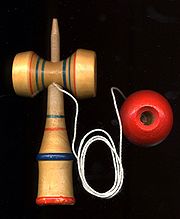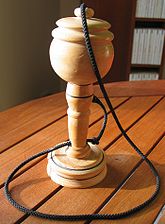
Kendama
Encyclopedia

Japan
Japan is an island nation in East Asia. Located in the Pacific Ocean, it lies to the east of the Sea of Japan, China, North Korea, South Korea and Russia, stretching from the Sea of Okhotsk in the north to the East China Sea and Taiwan in the south...
ese toy
Toy
A toy is any object that can be used for play. Toys are associated commonly with children and pets. Playing with toys is often thought to be an enjoyable means of training the young for life in human society. Different materials are used to make toys enjoyable and cuddly to both young and old...
which consists of a wooden, hammer-like object with a ball connected to it by a string. In English, kendama may be referred to as ring and pin and bears similarities to the classic cup-and-ball game, known in the Latin American world as balero. The principle of these toys are the same: catching one object with another, where both are joined by a string.
Using a kendama
To play with a kendama, one grips the toy and using one hand only, jerks the ball so that it may be caught in one of the cups or impaled on the spike. More advanced tricks are sequential balances, juggles, and catches.There are eleven prescribed moves on the kendama trick list for achieving a kyu ranking and several more for a dan ranking. A 1-kyu rating, for example, is attained by simply catching the ball in the largest cup. A book published by the Japan Kendama Association lists 101 different tricks for the toy and there are supposedly tens of thousands of trick variations. Different stances and grips are required to perform different tricks.
While most people play with kendamas for personal satisfaction, competitions do take place, especially in Japan. Participation in such competitions entails performing lists of tricks in sequence or completing particular tricks repeatedly for as long as possible. Additionally, tricks may be performed head to head with a rival to determine a winner. The competitor who is first to fail a trick loses.
In the trick moshikame , the ball is juggled between the big cup and the smallest cup at the bottom repeatedly. A Japanese children's song of the same name is often sung to help with timing.
Anatomy of a modern kendama
The main body of the kendama is called the .At one end of the ken is a spike - in Japanese -used to perform a basic trick whereby one flicks the kendama with one hand and 'spears' the ball on the point. At the other end of the ken is the grip, which is tailored to prevent the kendama from flying out of one's hand. This is called the slip stop, or in Japanese, . The ball—called a —features a hole drilled partway through, enabling it to be speared on the spike. The ball is connected to the ken with a length of string measuring approximately forty centimetres (sixteen inches). The two extending sides of the kendama are concave cups; one is smaller than the other. The larger cup is called the and the smaller cup is called the . The crosspiece which joins the cups to the ken is called the . There is another, smaller cup, called the at the bottom of the ken.
General origins and history

It is known in places as diverse as the Arctic
Arctic
The Arctic is a region located at the northern-most part of the Earth. The Arctic consists of the Arctic Ocean and parts of Canada, Russia, Greenland, the United States, Norway, Sweden, Finland, and Iceland. The Arctic region consists of a vast, ice-covered ocean, surrounded by treeless permafrost...
, France
France
The French Republic , The French Republic , The French Republic , (commonly known as France , is a unitary semi-presidential republic in Western Europe with several overseas territories and islands located on other continents and in the Indian, Pacific, and Atlantic oceans. Metropolitan France...
, and Peru
Peru
Peru , officially the Republic of Peru , is a country in western South America. It is bordered on the north by Ecuador and Colombia, on the east by Brazil, on the southeast by Bolivia, on the south by Chile, and on the west by the Pacific Ocean....
.
The French game bilboquet, a forerunner of the kendama, was played as early as the 16th century.
The game was popular in the royal courts of Europe, where players caught a swinging ball in a cup at the end of the handle. In North America, the game was both a child's toy and a gambling mechanism for adults, and involved catching a ring rather than a ball. In some native American tribes it was even a courtship device, where suitors would challenge the objects of their interest to a polite game of ring and pin. The Mohave variant of the game included up to 17 extra rings attached to the cord, and game scoring involved differing point values assigned to different rings. Other variants include those played by the Inuit
Inuit
The Inuit are a group of culturally similar indigenous peoples inhabiting the Arctic regions of Canada , Denmark , Russia and the United States . Inuit means “the people” in the Inuktitut language...
of what is now Labrador
Labrador
Labrador is the distinct, northerly region of the Canadian province of Newfoundland and Labrador. It comprises the mainland portion of the province, separated from the island of Newfoundland by the Strait of Belle Isle...
, with a rabbit's skull in place of the ball, with extra holes bored into it, which had to be caught on the handle like a skewer; and those that used balls of grass or animal hair. This game was also popular in England during the early 19th century, as Jane Austen
Jane Austen
Jane Austen was an English novelist whose works of romantic fiction, set among the landed gentry, earned her a place as one of the most widely read writers in English literature, her realism and biting social commentary cementing her historical importance among scholars and critics.Austen lived...
is reputed to have excelled while entertaining her brother's son in a game called bilbocatch.
Japanese origins
Although Japan's indigenous people, the AinuAinu people
The , also called Aynu, Aino , and in historical texts Ezo , are indigenous people or groups in Japan and Russia. Historically they spoke the Ainu language and related varieties and lived in Hokkaidō, the Kuril Islands, and much of Sakhalin...
, had invented their own kendama-type game, it is considered most likely that the modern Japanese toy was derived from a European import. According to this assumption, the kendama arrived in Japan via the Silk Road in around 1777, at which point Nagasaki was the only port open to foreign trade. Reportedly, kendama was initially a sort of adult's drinking game - a player who made a mistake was forced to drink more.
In 1876 Japan's Ministry of Education wrote a report which mentioned kendama, suggesting that the game had by then been adopted by Japanese children.
In the early 20th century, the toy had two side cups and was called a nichigatsu ball . This translates to 'sun and moon ball', named so because of the ball's representation of the sun and the cups' likeness to the crescent moon.
In 1919, Hamaji Egusa applied for a patent on the 'ball and cup' style toy and it was awarded in 1920. The size and proportions of the toy were later altered. The current competition design descends from Issei Fujiwara's model of the 1970s which featured string holes in the crosspiece. Little deviation has been made from his basic design, with the exception of the ken becoming more rounded to reduce wood chipping. It was also Fujiwara who established the Japan Kendama Association, which established the rules for play, the grading system now in use, and organised competition. In order to ensure that the toy was suitable for use in competition, the JKA also standardised kendama itself.
Today, kendama is popular in many parts of the world. Kendama is, of course, particularly well-loved in Japan, where national tournaments are held and Japanese employers recognise applicants who have attained the higher dan rankings as "persistent, patient and determined potential employees".
After a recent tour of Japan a large group of influential Aggressive inline skaters learnt of Kendama, and many of them (including Franky Morales) took to the activity, encouraging its spread amongst western aggressive inline skaters. A series of popular YouTube videos have been published as a result of this, and resulted in a significant spread of Kendama in the western world.
Kendama organizations
- Japan Kendama Association, Japan
- British Kendama Association
- Kendama USA - American Kendama Association, United States
- Balero Players’ Association – International, United States
- Federacion Internacional de Balero, Mexico
- Fédération Internationale de Bilboquet, France
- Kendama forum, kendama.freeforums.ms
Kendama tricks
- Around the World- big cup-little cup-tower-spike
- Slip on Spike- crossbar to sliding spike
- Earth Spin- spike to flip back on spike
- Around Japan- big cup-little cup- spike
- Around Europe-spike-big cup-spike-little cup-spike-tower-spike
- Bird- balance ball between spike and cup
- Under Bird- balance ball between cup and tower
- Lighthouse- balance tower on ball
- Airplane- swing ken to land spike while holding the ball
External links
- iKendama App for iPhone and iPod Touch Animated library of tricks and combos
- Kendama.Org English kendama history and a description of the JKA competition kendama
- British Kendama Association

